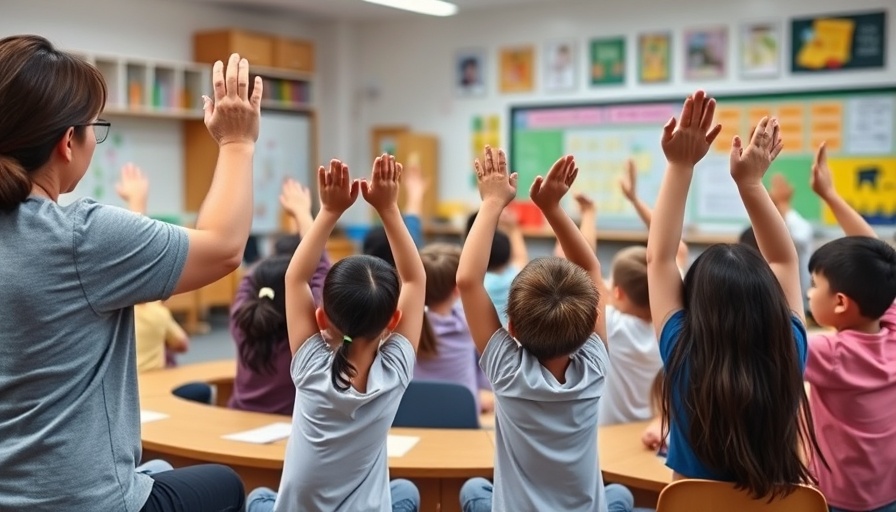
Empowering Students Through Mindfulness in the Classroom
In the wake of hurricane Helen, many students have faced significant emotional and academic challenges. The disruption of their usual environments, coupled with displacement due to damaged homes, has created a pressing need for strategies that not only address academic performance but also students’ emotional wellness. Traditional educational methods may no longer suffice; educators are increasingly turning to mindfulness practices, such as yoga and breathing exercises, to help students cope and thrive.
In 'These Simple Classroom Exercises Can Improve Student Behavior,' the discussion dives into the importance of mindfulness in schools, exploring key insights that sparked deeper analysis on our end.
Understanding the Role of Mindfulness in Education
Mindfulness activities provide students with the tools they need to navigate their feelings, focus their minds, and regulate their behaviors. Contrary to the common misconception that yoga needs large mats and a spacious environment, these exercises can be adapted to any classroom setting. Simple breathing techniques, such as “breathe in all the love and blow out all the stuff you don’t want,” can be practiced even in tight corners.
Proven Benefits: How Movement Supports Learning
Recent studies reveal a strong correlation between increased movement and improved learning outcomes. Rather than merely encouraging students to run wildly around the playground, teachers are now integrating mindful movements into their daily schedules. These movement breaks are designed to enhance students’ self-regulation, a skill essential for maintaining focus and motivation throughout the school day. The structure of these breaks aligns with the needs of children, particularly those who struggle with excess energy or emotional distress.
Transformative Impact on Student Behavior
Teachers who have implemented mindfulness techniques have witnessed remarkable changes in their students. One educator observed that students who previously struggled to concentrate or who often melted down have transformed into more engaged and autonomous learners. “It’s incredibly rewarding to see students who come in with a cloud of sadness turn into brighter versions of themselves,” the teacher stated.
Building Long-Term Resilience Through Mindfulness
Mindfulness doesn’t just benefit students in the short term. As kids learn how to manage overwhelming feelings and challenges, they develop resilience. This is critical, especially in today’s context where many children face mental health crises. Equipping students with the ability to calmly respond to stressors prepares them for more significant challenges they might encounter as teenagers and adults. Instead of heading toward paths that might lead to frustration or behavioral issues, they gain essential life skills that foster positive social interactions.
Practical Insights for Educators: Implementing Mindfulness in the Classroom
For teachers looking to introduce mindfulness into their curriculum, here are a few simple strategies:
- Start Small: Begin with short breathing exercises at the start of the day to set a calm tone.
- Daily Movement Breaks: Integrate 5-10 minute movement breaks throughout the day focused on mindful activities.
- Empower Students: Allow students to choose when they feel they need a mindfulness break, giving them agency over their emotional well-being.
Encouraging Teacher Support and Collaboration
The practicality of mindfulness training must also extend to supporting teachers. As classroom demands can be overwhelming, the introduction of these mindfulness activities should be user-friendly. Training sessions and resources provided to teachers can ensure they feel confident and adequately supported in implementing these vital strategies. Collaboration among educators can also lead to the development of a community that collectively addresses students’ emotional needs.
As we promote a new era of education, integrating mindfulness into everyday routines can yield significant benefits not just for students but for teachers as well. By fostering resilience, focus, and emotional regulation, educators can nurture a generation of well-rounded individuals better equipped to face the world.
Mindfulness and movement in education serve as a crucial pivot for shaping the future of our students. By embracing these practices, we’re not only influencing individual lives but also setting the stage for healthier communities.
Teachers and school administrators interested in discovering more techniques to incorporate mindfulness in their classrooms, remember that every small step helps in creating positive change.
 Add Row
Add Row  Add
Add 




Write A Comment